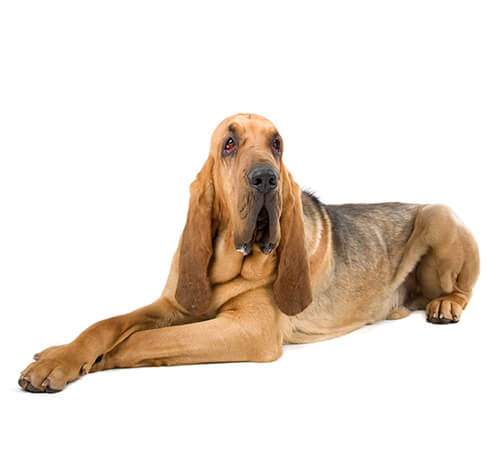
With his keen scent ability, the Bloodhound is used worldwide as a tracking dog in criminal searches and rescue efforts. This breed descended from the St. Huberts Hound of eighth century Belgium. Kind, docile and affectionate, the Bloodhound is a good family pet. The breed has a distinctive look due to abundant loose skin that hangs around the head and neck forming deep folds. The coat should be groomed weekly.
DID YOU KNOW? The Bloodhound’s name refers to the pure-blood breeding of this hound. Bloodhounds are such accurate trackers that they have produced evidence that has been accepted in a court of law.
ALSO KNOWN AS: Chien de Saint-Hubert, St. Hubert Hound
The need-to-know
- Dog suitable for owners with some experience
- Extra training required
- Enjoys active walks
- Enjoys walking one to two hours a day
- Large dog
- Minimum drool
- Requires grooming once a week
- Non hypoallergenic breed
- Chatty and vocal dog
- Not a guard dog
- May require training to live with other pets
- May require training to live with kids
Personality

These are gentle-natured, affectionate dogs who usually get on well with children and can live in harmony with other dogs and household pets. They are friendly dogs who will welcome both wanted and unwanted visitors. Although quiet in the house, they can be very vocal outdoors. They are family dogs and do not like to be left alone.
History and Origins

Country of Origin: Belgium
The ancestry of modern Bloodhound dog breeds can be traced back to the monastery of St. Huberts where dogs called St. Hubert’s Hounds were originally used to track wolves, big cats or deer, or to follow the trail of wounded game. The pale white versions of the breeds went on to be known as the Talbot Hound whereas the black and tans were called Bloodhounds.The Bloodhound was brought to Britain by William the Conqueror and it was used for stag-hunting - following a wounded animal sometimes for amazingly long distances.
Nutrition and Feeding

Large breed dogs, as well as having large appetites, benefit from a different balance of nutrients including minerals and vitamins compared to smaller-breed dogs. The Bloodhound is prone to bloating and stomach problems; smaller, more frequent meals can help minimise this risk.
Exercise

As adults, the Bloodhound has phenomenal stamina and needs two-plus hours daily - but this needs to be sniffing exercise and not just mindless walking. Primarily tracking dogs, once on the trail of an enticing smell, they will be desperate to find its source! Because of their size and growth rate, they must not be over-exercised as puppies. Care must be taken in the first year to ensure their bones and joints are given a proper chance to grow.
Other Information

Health and common issues
As with many breeds, Bloodhound breeds can suffer from hip dysplasia (a condition that can lead to mobility problems). Hip scoring of dogs prior to breeding is therefore important. The droopy skin on the head of Bloodhounds can result in problems with the eyelids and eyes. The breed club monitor the health of the breed carefully and should be contacted for the most up-to-date information and details of any DNA or additional testing they recommend. Breed Clubs can be found on the Kennel Club website.
Space requirements
This is a big dog who needs a lot of countryside to sniff in! They will appreciate a big garden too - and you can use this for scent games at home.
Training bloodhounds
The Bloodhound has little to no interest in any form of training that doesn’t involve using their nose! While they should be trained to walk (run!) on a harness and lead, finding a class where you can learn scentwork and sniffing games can give your Bloodhound an outlet for using their extraordinary nose and will keep them healthy and happy.
Best family dog breeds
The Bloodhound makes a great dog for families as they are gentle and patient. They may be too big and slightly clumsy for smaller children however. While many dogs are traditionally thought of as being good with children, all dogs and children need to be taught to get on with and respect each other, and be safe together. Even so, dogs and young children should never be left alone together and adults should supervise all interactions between them.
Did you know?
- When James Earl Ray, the murderer of Martin Luther King, escaped from prison in 1977, he was only recaptured thanks to a pack of Bloodhounds who tracked him down several days later in the mountains of Tennessee.
- One of the most successful Bloodhounds who was responsible for tracking escaped criminals in Kentucky recaptured over 600 fugitives. In one notable case, the trail ran for 138 miles and was 104 hours old.
- Such is the regard for their scenting abilities, in many states of the US, a Bloodhound’s evidence in court cannot be challenged.